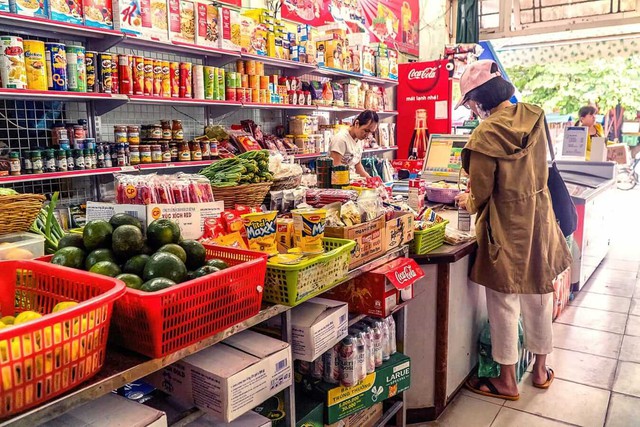
In particular, the consumer price index (CPI) for February 2024 increased by 1.04% compared to the previous month; increased by 1.35% compared to December 2023 and increased by 3.98% compared to the same period in 2023. The average for the first two months of 2024, CPI increased by 3.67% compared to the same period last year.
The report stated that in the 1.04% increase in CPI for February 2024 compared to the previous month, there were 9 groups of goods and services with increased price indexes, and 2 groups of goods with decreased price indexes.
Accordingly, the 9 groups of goods and services with increased price indexes include:
– The transportation group increased the most, by 3.09% (contributing to a 0.3 percentage point increase in the overall CPI), including: The public transportation service index increased by 15.48% due to increased travel demand during the Lunar New Year holiday season; the gasoline price index increased by 5.82%, the diesel price index increased by 5.51% due to the impact of domestic gasoline and diesel price adjustments; car wash and pumping services increased by 2.47%; parking services increased by 1.86%; vehicle maintenance services increased by 0.52%; the price of motorcycle tires and inner tubes increased by 0.21%; the price of other motorcycle spare parts increased by 0.15%.
– The food and beverage group increased by 1.71% (contributing to a 0.57 percentage point increase in the overall CPI), including: Food increased by 1.75%[ (contributing to a 0.06 percentage point increase in the overall CPI); food increased by 1.98% (contributing to a 0.42 percentage point increase in the overall CPI); eating out increased by 1.04% (contributing to a 0.09 percentage point increase in the overall CPI).
– The beverage and tobacco group increased by 0.8% due to increased consumption and use as gifts during the Lunar New Year holiday, leading to increased prices of alcohol and beer by 1.17%; cigarettes increased by 0.56%; non-alcoholic beverages increased by 0.33%.
– The culture, entertainment and tourism group increased by 0.79% due to shopping and traveling during the Lunar New Year holiday season (contributing to a 0.04 percentage point increase in the overall CPI), mainly focusing on the following categories: The price of flowers, plants and landscapes increased by 4.19%; entertainment services increased by 1.09% (including a 15.41% increase in ticket prices for movies and music performances); package tours increased by 1.67% (domestic tourism increased by 1.68%; international tourism increased by 1.63%); hotel prices increased by 0.99%.
– The other goods and services group increased by 0.78%, mainly due to price increases in some categories: Hair cutting and washing services increased by 2.88%; jewelry group increased by 2.61%; personal care services increased by 1.92%. Due to the wedding season, the prices of wedding-related products and services increased by 0.25%. In addition, the demand for worshiping items during the holidays increased, causing the prices of these items to increase by 0.62% compared to the previous month.
– The housing and construction materials group increased by 0.43% (contributing to a 0.08 percentage point increase in the overall CPI).
– The equipment and household goods group increased by 0.26%.
– The clothing and footwear group increased by 0.16% due to labor costs, material costs, and shopping demand during the Lunar New Year holiday season.
– The medicine and health services group increased slightly by 0.02%, in which the price index of various medicines increased by 0.11%; the price of medical examination and treatment services remained unchanged compared to the previous month. The main reason is that some pain relievers, fever reducers, anti-inflammatory drugs, and respiratory system drugs have increased in price due to the humid weather conditions in some localities in the North.

Month-on-month CPI growth/decline in February 2024. Source: General Statistics Office
Conversely, the 2 groups of goods and services with decreased price indexes include:
– The posts and telecommunications group decreased by 0.17% due to businesses implementing discount programs for some types of older mobile phones.
– The education group decreased by 0.42% compared to the previous month (contributing to a 0.03 percentage point decrease in the overall CPI), including a 0.48% decrease in education services. The main reason is that on December 31, 2023, the Government issued Resolution No. 97/2023/NĐ-CP amending and supplementing some provisions of Decree No. 81/2021/NĐ-CP dated August 27, 2021 of the Government, which requires stabilizing the tuition fees for the 2023-2024 academic year at the tuition fee level of the 2021-2022 academic year for public preschool education and public general education. As a result, some localities have adjusted the tuition fees after collecting them according to Decree No. 81/2021/NĐ-CP.
Core inflation in February 2024 increased by 0.49% compared to the previous month and increased by 2.96% compared to the same period last year. In the first two months of the year, core inflation increased by 2.84% compared to the same period last year, lower than the average overall CPI increase (3.67%), mainly due to the prices of food, gasoline and oil, medical services, and education services, which are excluded from the calculation of core inflation.





































